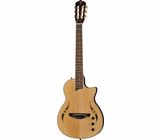The Man-in-the-Moon signed the Quality Control release note on my Harley Benton Nashville, nylon string. For when it arrived it has only 5 strings….working. I checked my order. Yes it said 6-strings. I checked my other eight guitars. Yes 6-strings. So what is going on?
The D string didn’t match the set on the guitar and emitted no sound….AT ALL. Goodness. Was this manufactured prior to 1700 when guitars were 5-string instruments?
What on earth is going on? Ahhhh. Got it. Change the rogue string for a shiny new one that matched the set. Tuned up. BUT still no sound. Hhhhmmm.
As Germany isn’t next door, I couldn’t walk to Thomann and knock. I removed the saddle. Sure enough the piezo pickup was intact. What next to check?
Oooops. I dropped the shiny, white saddle piece I’d removed. But it didn’t fall onto the floor. It floated up to the ceiling and remained there. I stood on a chair to retrieve it. Wow it was featherlight. On its underside I noticed that it had ejection holes from the plastic moulding process. I inserted a proper bone saddle into the bridge, tuned-up and whey-hey – Music arrived at the D-string. So the holes on the underside of the supplied saddle were preventing the piezo (pressure) effect from working.
No problem.
Except my bone saddle was straight edge at the top and the removed one had a radius. Into my workshop. Rough emery paper needed. When the radius matched. Back to fit. But the height of the 6th string at the 12th fret was enormous. Back to the emery to grind its bottom. Careful check, but still too high. Sanded some more and happy.
Now for the grey and dusty-looking fretboard. Got the Linseed oil out and with the drenched cloth, gave it a scrub. Goodness. I now have a wonderful-looking dark brown fretboard. That worked.
Now to tune the guitar. But I couldn’t as the tuners on the unseen-side, wouldn’t twist. They were stuck. So I turned the guitar to left-handed and gave the tuners an angry stare. Oh dear. What to do? Adjusting the torque on the screws didn’t work. Greasing the barrels didn’t work. Then I spotted that the nylon barrels were badly fitted into the wood. Oiled both sides and Hey presto, the winders began to turn.
Someone rang my house bell. Went to investigate. Good news. My Butler, who I hired earlier, had arrived. So I sat on my stool with my left thigh raised in the Classical position, waiting. He then lifted the guitar onto my thigh. Now I was anchored for the next hour and a quarter. So dismissed the Butler and asked him to return after practise to release me.
You’ve guessed correctly. This guitar is HEAVY.
I heard on the news that someone has stolen a section of hi-speed rail track. I have found it. It is fitted into my HB Nashville to separate each fret. Then hammered into a distinct radius. These enormous frets mean that your left-hand fingers disappear each time you finger a note. As it takes time to extricate your finger from the deep and move it to the next note, I can only play Adagio. Tunes like Brahms lullaby and Silent Night - over and over.
Talking of frets, there are 16 before the neck meets the body. You can overcome this enormous distance by re-arranging all your music from the first position to the 5th position. That was still a stretch. Chose to move to the more playable 10th position. After all there are 21 frets to explore.
The plastic (again) nut is 48mm width. You therefore expect that the width across all 6 strings will be 40mm, giving an 8mm gap. But no. It measures 39mm. What!
Playing fingerstyle, I found my right-hand seemed content. Big surprise on measuring the string spacing at the bridge. It is the Classical 60mm. A 48mm nut normally ends up 57.5mm at the bridge. The extra width helps playability.
The guitar is slim at 45mm and is smaller by 50mm across the bouts. It sits well on your thigh.
The White House requested an audience to hear its timbre. The Royal Albert Hall too. I tossed and turned wondering what tune would suit. Then I woke up.

